Mine sweeping on:
[Wikipedia]
[Google]
[Amazon]

 Minesweeping is the practice of the removal of explosive
Minesweeping is the practice of the removal of explosive
 Aircraft can also be used for minesweeping. During the Second World War, fifteen British Vickers Wellington bombers were modified to carry a large magnetic induction loop and an electrical generator. The "Directional Wireless Installation" (DWI), a cover story for the true purpose of the magnetic loop, was used successfully on 10 May 1940 to sweep a path for the escape of the Dutch Royal Family to the UK. The DWI was used most successfully in the Mediterranean Theatre, particularly over the
Aircraft can also be used for minesweeping. During the Second World War, fifteen British Vickers Wellington bombers were modified to carry a large magnetic induction loop and an electrical generator. The "Directional Wireless Installation" (DWI), a cover story for the true purpose of the magnetic loop, was used successfully on 10 May 1940 to sweep a path for the escape of the Dutch Royal Family to the UK. The DWI was used most successfully in the Mediterranean Theatre, particularly over the

 Minesweeping is the practice of the removal of explosive
Minesweeping is the practice of the removal of explosive naval mine
A naval mine is a self-contained explosive device placed in water to damage or destroy surface ships or submarines. Unlike depth charges, mines are deposited and left to wait until they are triggered by the approach of, or contact with, any ...
s, usually by a specially designed ship called a minesweeper using various measures to either capture or detonate the mines, but sometimes also with an aircraft made for that purpose. Minesweeping has been practiced since the advent of naval mining in 1855 in the Crimean War
The Crimean War, , was fought from October 1853 to February 1856 between Russia and an ultimately victorious alliance of the Ottoman Empire, France, the United Kingdom and Piedmont-Sardinia.
Geopolitical causes of the war included the de ...
. The first minesweepers date to that war and consisted of British rowboats trailing grapnels to snag the mines.
By ship
A sweep is either a contact sweep, a wire dragged through the water by one or two ships to cut the mooring wire of floating mines, or a distance sweep that mimics a ship to detonate the mines. The sweeps are dragged by minesweepers, either purpose-built military ships or convertedtrawlers Trawler may refer to:
Boats
* Fishing trawler, used for commercial fishing
* Naval trawler, a converted trawler, or a boat built in that style, used for naval purposes
** Trawlers of the Royal Navy
* Recreational trawler, a pleasure boat built tra ...
. Each run covers between , and the ships must move slowly in a straight line, making them vulnerable to enemy fire. This was exploited by the Turkish army in the Battle of Gallipoli in 1915, when mobile howitzer
A howitzer () is a long- ranged weapon, falling between a cannon (also known as an artillery gun in the United States), which fires shells at flat trajectories, and a mortar, which fires at high angles of ascent and descent. Howitzers, like ot ...
batteries prevented the British and French from clearing a path through minefields.
If a contact sweep hits a mine, the wire of the sweep rubs against the mooring wire until it is cut. Sometimes "cutters", explosive devices to cut the mine's wire, are used to lessen the strain on the sweeping wire. Mines cut free are recorded and collected for research or shot with a deck gun. Before the First World War
World War I (28 July 1914 11 November 1918), often abbreviated as WWI, was one of the deadliest global conflicts in history. Belligerents included much of Europe, the Russian Empire, the United States, and the Ottoman Empire, with fightin ...
, the Imperial Russian Navy
The Imperial Russian Navy () operated as the navy of the Russian Tsardom and later the Russian Empire from 1696 to 1917. Formally established in 1696, it lasted until dissolved in the wake of the February Revolution of 1917. It developed from a ...
officer Pyotr Kitkin
Pyotr Pavlovich Kitkin () (12 June 1877 – 18 September 1954) was a Russian military commander in the First and Second World Wars, being promoted twice to Rear Admiral, once by the Imperial Russian Navy on 28 July 1917, and once by the Soviet ...
invented "mine protectors" to break a sweeping wire before it could cut the mine's mooring wire.
Minesweepers protect themselves with an oropesa or paravane instead of a second minesweeper. These are torpedo-shaped towed bodies, similar in shape to a Harvey Torpedo
Harvey, Harveys or Harvey's may refer to:
Arts, entertainment, and media
* ''Harvey'' (play), a 1944 play by Mary Chase about a man befriended by an invisible anthropomorphic rabbit
* Harvey Awards ("Harveys"), one of the most important awards ...
, that are streamed from the sweeping vessel thus keeping the sweep at a determined depth and position. Some large warships were routinely equipped with paravane sweeps near the bows in case they inadvertently sailed into minefields—the mine would be deflected towards the paravane by the wire instead of towards the ship by its wake. More recently, heavy-lift helicopters have dragged minesweeping sleds, as in the 1991 Persian Gulf War.
The distance sweep mimics the sound and magnetism of a ship and is pulled behind the sweeper. It has floating coils and large underwater ''drums''. It is the only sweep effective against bottom mines.
During the Second World War, RAF Coastal Command used Vickers Wellington bombers Wellington DW.Mk I fitted with degaussing coils to trigger magnetic mines.
Modern influence mines are designed to discriminate against false inputs and are much more difficult to sweep. They often contain inherent anti-sweeping mechanisms. For example, they may be programmed to respond to the unique noise of a particular ship-type, its associated magnetic signature and the typical pressure displacement of such a vessel. As a result, a mine-sweeper must accurately guess and mimic the required target signature to trigger detonation. The task is complicated by the fact that an influence mine may have one or more of a hundred different potential target signatures programmed into it. Slide 34 of 81. Hosted by Federation of American Scientists.
Another anti-sweeping mechanism is a ship-counter in the mine fuze. When enabled, this allows detonation only after the mine fuze
In military munitions, a fuze (sometimes fuse) is the part of the device that initiates function. In some applications, such as torpedoes, a fuze may be identified by function as the exploder. The relative complexity of even the earliest fuze d ...
has been triggered a pre-set number of times. To further complicate matters, influence mines may be programmed to arm themselves (or disarm automatically—known as ''self-sterilization'') after a pre-set time. During the pre-set arming delay (which could be days or weeks) the mine would remain dormant and ignore any target stimulus, whether genuine or faked.
When influence mines are laid in an ocean minefield, they may have various combinations of fuze settings configured. For example, some mines (with the acoustic sensor enabled) may become active within three hours of being laid, others (with the acoustic and magnetic sensors enabled) may become active after two weeks but have the ship-counter mechanism set to ignore the first two trigger events, and still others in the same minefield (with the magnetic and pressure sensors enabled) may not become armed until three weeks have passed. Groups of mines within this mine-field may have different target signatures which may or may not overlap. The fuzes on influence mines allow many different permutations, which complicates the clearance process.
Mines with ship-counters, arming delays and highly specific target signatures in mine fuses can falsely convince a belligerent that a particular area is clear of mines or has been swept effectively because a succession of vessels have already passed through safely.
By aircraft
 Aircraft can also be used for minesweeping. During the Second World War, fifteen British Vickers Wellington bombers were modified to carry a large magnetic induction loop and an electrical generator. The "Directional Wireless Installation" (DWI), a cover story for the true purpose of the magnetic loop, was used successfully on 10 May 1940 to sweep a path for the escape of the Dutch Royal Family to the UK. The DWI was used most successfully in the Mediterranean Theatre, particularly over the
Aircraft can also be used for minesweeping. During the Second World War, fifteen British Vickers Wellington bombers were modified to carry a large magnetic induction loop and an electrical generator. The "Directional Wireless Installation" (DWI), a cover story for the true purpose of the magnetic loop, was used successfully on 10 May 1940 to sweep a path for the escape of the Dutch Royal Family to the UK. The DWI was used most successfully in the Mediterranean Theatre, particularly over the Suez Canal
The Suez Canal ( arz, قَنَاةُ ٱلسُّوَيْسِ, ') is an artificial sea-level waterway in Egypt, connecting the Mediterranean Sea to the Red Sea through the Isthmus of Suez and dividing Africa and Asia. The long canal is a popular ...
and Alexandria Harbour
The Port of Alexandria is on the West Verge of the Nile Delta between the Mediterranean Sea and Mariut Lake in Alexandria, Egypt, and is considered the second most important city and the main port in Egypt. Alexandria port consists of two harbours ...
. Their use revealed the limitations of the technique, in that it only works effectively in very shallow water (such as canals and harbours). From about 1943, German
German(s) may refer to:
* Germany (of or related to)
**Germania (historical use)
* Germans, citizens of Germany, people of German ancestry, or native speakers of the German language
** For citizens of Germany, see also German nationality law
**Ger ...
Junkers Ju 52
The Junkers Ju 52/3m (nicknamed ''Tante Ju'' ("Aunt Ju") and ''Iron Annie'') is a transport aircraft that was designed and manufactured by German aviation company Junkers.
Development of the Ju 52 commenced during 1930, headed by German Aeros ...
transports were similarly converted. Blohm & Voss BV 138 MS tri-motor flying boats were also used for this purpose.
The MH-53E Sea Dragon helicopter is used primarily by the United States Navy to tow several types of mine hunting or mine sweeping gear through the water. It replaced the earlier, RH-53A and RH-53D variants of the Sikorsky CH-53 Sea Stallion. Other examples of minesweeping helicopters include the RH-3A variant of the Sikorsky SH-3 Sea King, as well as the Mi-14BT variant of the Mil Mi-14
The Mil Mi-14 (russian: Миль Ми-14, NATO reporting name: Haze) is a Soviet shore-based nuclear-capable amphibious anti-submarine helicopter derived from the earlier Mi-8.
Design and development
Formal development of an anti-submarine warfa ...
and the MCH-101 variant of the Augusta Westland AW101
Augusta may refer to:
Places Australia
* Augusta, Western Australia
Brasil
* Rua Augusta (São Paulo)
Canada
* Augusta, Ontario
* North Augusta, Ontario
* Augusta Street (Hamilton, Ontario)
France
* Augusta Suessionum ("Augusta of the Suess ...
.
See also
*Minehunter
A minehunter is a naval vessel that seeks, detects, and destroys individual naval mines. Minesweepers, on the other hand, clear mined areas as a whole, without prior detection of mines. A vessel that combines both of these roles is known as a ...
References
External links
* {{cite EB1922 , last=Dewar , first=Alfred , wstitle=Minesweeping and Minelaying, volume=31 , pages=949–995 , short=x Mine warfare Mine action